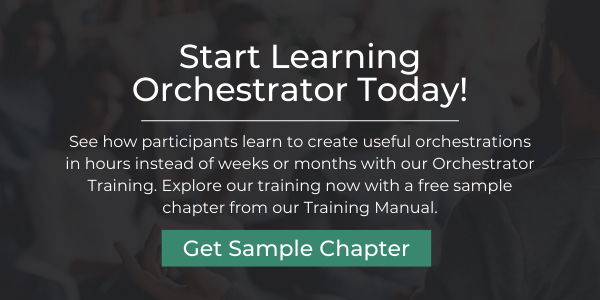Become a Citizen Developer with the JD Edwards Orchestrator
Everyone knows that most IT departments are too overwhelmed to keep up with new requests from users. It doesn’t matter how much time the proposed applications would save the business. There simply isn’t enough room in the pipeline for all the good ideas end users bring to the table.
That’s why it’s been exciting to see the “citizen developer” trend put the power of technology into the hands of JD Edwards business users. The Orchestrator is a perfect example of a low code/no code tool that lets business analysts build what they need using IT-approved tech but without requiring developer resources.
Let’s explore what some JDE Orchestrator examples from our ACBM trainees.
A Tale of Three Citizen Developers
At ACBM, we can share countless stories about how our training participants put their knowledge to work. Here are a few real-life use cases to help spark ideas for your own projects.
Daily Exchange Rate Updater
Melody and her team were in the middle of an ACBM Orchestrator training session when the trainer had to step away to handle a pre-scheduled commitment. Instead of going on break for that hour, Melody and the other trainees decided to build an orchestration to automate exchange rate entry into the JDE. By the time the session resumed, the team already had a proof of concept. With a few tweaks it was ready to go into production.
The best part? The tools Melody had been looking at to solve her exchange rate updating problem cost between $10-15k. She just saved her company ten grand and looks like a hero!
“I expected a lot out of the EnterpriseOne Orchestrator. Now my team is off and running. We have a lot of ideas we are able to quickly put into place without any assistance.”
- Melody Bivona, Manager of Applications Architecture, PennEngineering
Streamlined PO Approval Process
After completing training, Josh wanted to set up an orchestration to send out automatic notifications for PO approval. Here’s how that turned out.
- Every time a PO is created, it automatically triggers an orchestration that sends an email to the approver.
- The orchestration determines the correct information and approver based on who submitted the PO, the amount, and other factors.
- It pulls all this information into the email along with links that give the approver options to review and complete the approval directly from the email or within the JDE.
- This solution features JD Edwards Form Extensions (a popular citizen developer tool) to invoke the orchestration and pull personalized information into each email notification.
Automating this workflow reduced clicks, bottlenecks, and delays in the approval process.
Automatic SQL Database Updates
Gerald works at a scientific supply company, and he decided to do an experiment of his own right after graduating from our 5-day class on orchestrations. His first self-built orchestration was designed to update forecast files in a SQL database automatically. Previously, the process of making updates required custom programming and several hours per month of work for IT and the end user. Now, it happens without anyone lifting a finger.
“With JDE plus the Orchestrator, we took the load off of IT and put responsibility and capability into the end users’ hands. We’re using standard functionality instead of customization, so there’s no need for advanced developer skills.” - Gerald Brundle, Carolina Biological Supply Company
The JDE Orchestrator Use Cases Are Limitless
Business users can leverage the JD Edwards EnterpriseOne Orchestrator to build what they need for IoT, application integration, web/mobile apps, and more. One of the most popular places to start is business process automation that features self-monitoring/running orchestrations to do mundane, rules-based tasks.
Here are a few things to keep in mind if you are new to being a citizen developer:
- The Orchestrator is user-friendly and easy to learn
- Everything is done at the application level
- You don’t have to interact with tables, fields, or business functions
- Custom code is rarely needed (less than 5% of the time)
As the business user, YOU know the applications and business process involved in what you are trying to accomplish. This makes YOU the right person to build what you need.
Want a jump start on using Orchestrator as a citizen developer? Schedule training for your team now.



